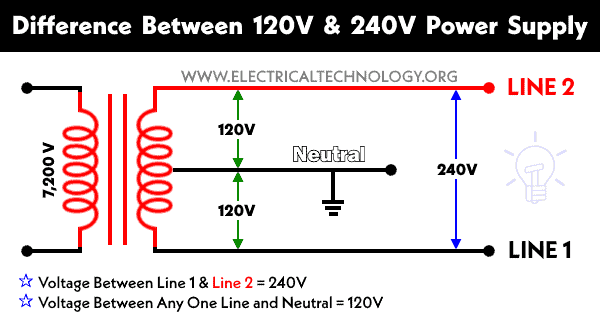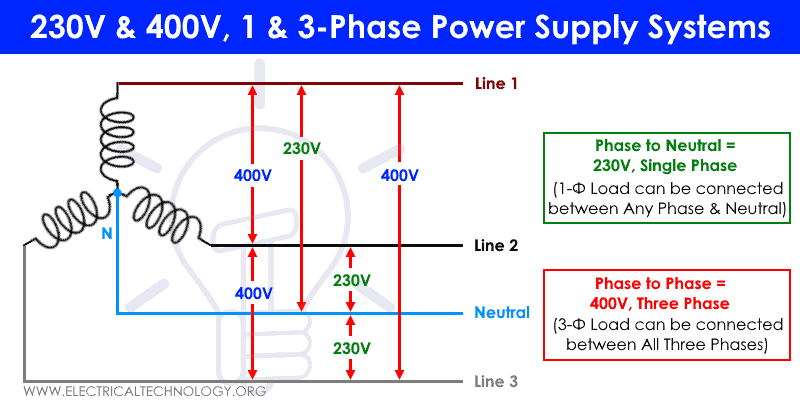What is the Difference Between 120V, 230V and 240V AC Power?
We all know that the common voltage levels available in the US for household applications are 120V and 240V however the rest of the world, especially the IEC following countries in the EU, UK, uses 230V while AUS etc. uses 220V, 230V and 240V.
In today’s post, we will be discussing the differences, standardizing, ratings, advantages and applications of both 120V & 240V/230V supply voltages.
In the era of 1870’s to 1890, Thomas Edison invented the 110V DC current with three wire power distribution systems. He additionally used the configuration of Two 110V + a Neutral wire to form 220V DC system. Later on, Nikola Tesla adopted the 110V AC for lighter load (like incandescent lamps) and 220V AC for large load applications.
At the end of the 19th century, a large number of electrical appliances and machines were brought to the US market and adopted by the home and businesses hence, it needed to have a standard voltage level for different applications. Hence, the 120V and 240V system was standardized in 1967 from early 110V, 115V and 220V.
In 1891, the era of DC power came to an end when the three phase AC power was brought and launched at a commercial base by Electro-Technical Exposition in Frankfurt Germany.
To improve the power transmission and distribution efficiency, the EU migrated to the 220-240V power supply system from the early but originally established 120V power. The US wants to migrate as well but they decide to remain on 120V with an additional 240V split phase system. This is because modifying the existing and well settled infrastructure to the new design and configuration would have proven costly. To avoid the hassle and lengthy but costly migration, they opt to add an additional split phase 240V supply voltage. That’s why US homes now have both the 240V and 120V AC power.
Related Posts:
- Why is the Standard Voltage in the US 120V/240V and 230V in the EU?
- Chart List of Standard Voltage and Frequency Around the World
120V
The common voltage level in the US homes for small load applications e.g. lighting points, refrigerator, mobile charging points and TVs etc. is 120V – AC. It is available between any hot wire (black or red) and neutral wire. Three wires configuration is used to obtain and power up a single phase load as follow.
Voltage between Black (Hot) and White (Neutral) + Green or bare conductor (Ground) = 120V – 60 Hz – AC.
Good to Know:
- The common US homes have both 120V (for lighter) and 240V (for higher load) supply voltage levels.
- Some of the countries like Japan and Taiwan use only one level of 100V to 127V single phase AC supply.
240V
There are some power eager appliances which need high power to run. For example, furnaces , dryers and washer, water heater and electric stoves and ranges etc. need extra power to properly operate. This is where US homes need 240V – 60Hz AC supply voltage.
240V AC voltage is available in US homes between any two hot wires. Three or four wires (neutral is needed in some cases) configuration is used to obtain and power up a split phase 240V load as follows.
Voltage between Black (Hot 1) and Red (Hot 2) + Green or bare conductor (Ground) = 240V – 60 Hz – AC.
One of the advantages of 240V power is that it supplies twice the power as compared to the power supplied by 120V AC. It has less amperes and needs a small gauge size of wire for carrying the same amount of power to a specified appliance. This is because power (in watts) is equal to the produce of voltage (in volts) and current (in amperes) e.g. P = V x I. or Watts = Volts x Amperes.
Good to Know: 240V outlet supplies almost double of electrical energy than 120V outlet.
Related Posts:
230V
Well, it is similar to 240V AC but not applicable in the US. Actually, 230V – 50Hz is a single phase AC supply voltage commonly used in the UK, EU, AUS and other IEC following countries.
The 230V – AC single phase power available across the three wires (2+1) e.g.
Voltage between Brown (Phase) and Blue (Neutral) + Green with yellow stripes (Ground = 230V – 50 Hz – AC.
Good to Know: The IEC following counters like UK, AUS, NZ, UAE, KSA, IND, PAK and other EU countries have only one level of single phase voltage level i.e. 220 to 230V with 50Hz of frequency.
Difference Between 120V, 240V and 230V.
240V (US – NEC) and 230V (UK, EU – IEC) are almost same levels of supply voltages. Therefore, we will show a comparison between 240V and 120V instead.
To be honest, there is not a noticeable difference between 240V and 120V level of voltages for consumers and end user appliances. Anyway, let’s show the key differences between the two level of voltages as follow:
- 240V and 230V AC supply is more efficient as compared to 120V AC i.e. it transfers more (almost twice as voltage is doubled) power than 120V AC.
- 240V requires less gauge size wire for the same amount of power to be transformed to a specified load. (P = V x I).
- Thinner wire gauge size is required in 240V circuit while thinker gauge wire size is needed in 120V circuit for the same wattage rating of appliances such as water heater.
- 240V is preferred for large eclectic motors as it needed high amperes for starting purpose in the initial stage.
- 240V/230V is more harmful than 120V when exposed directly to a human body.
- Voltage drop and I2R is higher in 120V than 240V for the same distance, wire size conductor and wattage application (Watts = Volts x Amps). Keep in mind that is negligible (3 to 5%) in home based wiring systems. For long distance, that’s why high voltage transmission is preferred over low voltage transmission to reduce energy losses.
- You can get 120V supply from 240V supply panel but can’t get 240V from 120V panel.
Related Posts:
Advantages of 240V supply over 120V supply
- You can transfer almost double the power with the help of 240V circuit as compared to 120V circuit.
- You can power up higher wattage appliances using 240V outlets. This is not possible in the case of a 120V outlet i.e. you will need to install an extra and separate outlet from the panel board.
- Not all appliances can be connected to the only available 120V power supply. Electric ranges and water heaters etc. need a dedicated 240V power supply which is not possible in case of 120V supply.
- Potentially, more power is available in case of a 30A – 240V breaker as compared to two 15A – 120V breakers. For example, a total of 6 numbers of 5A – 120V light bulbs can be connected to the two 15 Amps – 120V circuits while you may connect 12 numbers of 5A – 120V light bulbs to the 30A – 240V circuit.
Good to Know: Never ever connect the rated load for 120V to the 240V outlet as the 240V draws more power than the rated power. This may cause heat up the wires and cables which leads to severe hazardous fire and may damage the appliance. Additionally, it will trigger the unwanted tripping of the associated circuit breaker.
On the other hand, connecting a 240V load appliance (say water heater) to a 120V supply produces 25% of the rated wattage. In addition, small motor based devices may be damaged while operating on the wrong level of voltage.
Hence, it is suggested and recommended to only use the device with proper rated voltage levels. You may check and verify the device’s rating with the user manual from the manufacturer or nameplate date printed on it. Additionally, only rated for 100V to 250V devices can be connected to either 120V, 230V and 240V outlets.
Related Posts:
Is 240V Cheaper than 120V Electric Supply?
Short Answer is – NO but Little bit Yes.
Long answer: According to Joule’s Law, Watts is equal to volts times amperes (P = V x I). Now you may think twice the voltage (in 240V as compared to 120V) means double the power. Yes! you are correct. But this is not the case where electric supply providers charge you for. It is the wattage which is the product of voltage and current.
For example, if you connect a 100W lamp to 120V supply, it will draw 0.833 amps. Now if you connect the same light bulb to 240V supply, it will draw 0.4166 Amps. You see the the amperes in the 240V is less than 120V circuit, but the wattage rating is same in both cases i.e. 100W.
Now if you calculate the total wattage (for which the electricity providers charge you for e.g.
240V x 0.4166A = 99.9 ≈ 100 W
120V x 0.833A = 99.9 ≈ 100 W
Hence, your electricity bill will remain the same, no matter what level of voltage was used for the same wattage rating application.
Now, the second scenario is the wire gauge size. For example, you need thinner gauge wire size in 240V circuit while thicker gauge wire size for the same wattage rating and distance. Let’s see how?
For a 3000 watts water heater, you will need an 8 gauge (thicker) wire size when connected to a 120V circuit while 12 gauge (thinner) wire size is required in case of 240V circuit. (remember the P = V x I)
I = P / V
I = 3000W / 120V = 25A.
I = 3000W / 240V = 12.5A.
We see that less (almost half) current is flowing in the case of 240V circuits. If we add the 20% safety margin, we need 12 gauge wire size in 240V while 8 gauge wire size in 120V. Hence, you may save a little bit while selecting the wire size and sizing the protective devices such as circuit breakers as the small amperage products are less in size and cost.
In addition, power AC/DC inverters and converters operate efficiently when operated at higher voltage levels i.e. operating these devices on 240V instead of 120V saves a little bit but it wont make you rich.
Related Posts:
- Difference Between Single Phase and Three Phase Power Supply
- Why 3-Phase Power? Why Not 6, 12 or More for Power Transmission?
- If a 1-Phase Supply is 230V, Why is 3-Phase 400V & Not 690V?
- Difference Between Socket, Outlet and Receptacle
- Difference Between 50 Hz and 60 Hz Frequency System
- Which One is More Dangerous? 50Hz or 60Hz in 120V/230V & Why?
- Which Transformer is More Efficient When Operates on 50Hz or 60Hz?
- Can We Operate a 60Hz Transformer on 50Hz Supply Source and Vice Versa?
- Is it Possible to Operate a 50Hz Transformer on 5Hz or 500Hz Frequency?


 Should You Connect GND and 0VDC? Combined AC & DC Grounding
Should You Connect GND and 0VDC? Combined AC & DC Grounding Can you Combine AC and DC Ground in a Solar Installation?
Can you Combine AC and DC Ground in a Solar Installation? Why Doesn’t DC System Require a Grounding System Similar to AC System?
Why Doesn’t DC System Require a Grounding System Similar to AC System? Why are Capacitors Connected in Series in Power Lines?
Why are Capacitors Connected in Series in Power Lines? Why is a Capacitor Bank Connected in Parallel and Not in Series for P.F?
Why is a Capacitor Bank Connected in Parallel and Not in Series for P.F? How to Calculate the Floor Area For General Lighting?
How to Calculate the Floor Area For General Lighting?